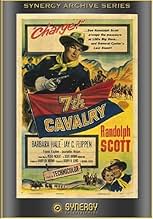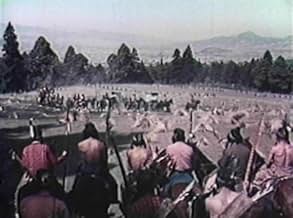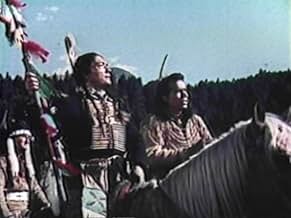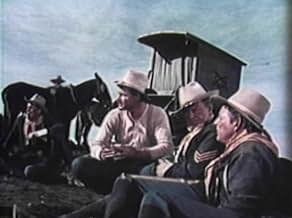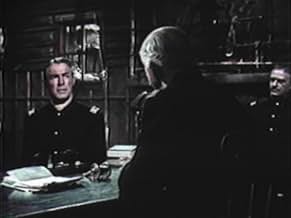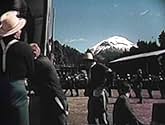IMDb-BEWERTUNG
5,8/10
1488
IHRE BEWERTUNG
Füge eine Handlung in deiner Sprache hinzuAn officer accused of cowardice volunteers to bring back General Custers's body after Little Big Horn.An officer accused of cowardice volunteers to bring back General Custers's body after Little Big Horn.An officer accused of cowardice volunteers to bring back General Custers's body after Little Big Horn.
- Regie
- Drehbuch
- Hauptbesetzung
Bill Clark
- Soldier With Kellogg
- (Nicht genannt)
Charles Horvath
- Knife-Wielding Indian
- (Nicht genannt)
William Leslie
- Lt. Murray
- (Nicht genannt)
Harold Miller
- Officer at Inquiry
- (Nicht genannt)
Empfohlene Bewertungen
Captain Thomas Benson returns to Fort Lincoln, the Seventh Cavalry's outpost in the Dakota wilderness, with Martha Kellogg, his bride-to-be. As the couple approach the fort, it is apparent that something is wrong. Benson enters to find the Seventh Cavalry's base strangely silent and motionless. Unknown to Benson, while he has been away General Custer has led the regiment to disaster at the Little Big Horn ...
The stillness and emptiness of the fort could serve as a metaphor for the film's lack of pace and content. The first half consists of endless breast-beating over the recent disaster, and the cavalrymen's torpid dialogue is unrelieved by motion or variety of any kind. It is fully 45 minutes before anything remotely resembling an action sequence occurs.
Benson is regarded with contempt by the remnants of the Seventh, both because he was Custer's favourite and because he managed to avoid the Little Big Horn. Matters are complicated by his choice of fiancee. Martha (Barbara Hale) is the daughter of Colonel Kellogg, the new commander of the regiment, and the man charged with investigating the recent military debacle.
A mundane and leaden horse opera, "Seventh Cavalry" lacks either a coherent structure, interesting action or even a convincing raison d'etre. Benson decides to rehabilitate himself by leading a burial detail out into the battlefield to recover the regiment's dead. He deliberately chooses the drunks and the shirkers, but it is never explained why these men, reluctant soldiers at the best of times, agree to be 'volunteered' for this dangerous work. Once in open terrain, Benson deserts his command to go chasing after a lone indian scout, in flagrant dereliction of his duty. During the pursuit, the two men ride past the same tree stump twice! They fight hand-to-hand, and Benson uses a stick to trap the indian's knife-wielding right hand. Why doesn't the indian simply transfer the knife to his free left hand?
The widow Mrs. Reynolds wails like a soothsayer in the deserted barracks, but neither her text nor her acting carry any conviction. The returning survivors of the Little Big Horn ride into Fort Lincoln, hamming up the weariness and weakness for all they are worth - but where did they acquire the neat, clean bandages? When Benson fights with the loud-mouth Vogel, the scrap is all too obviously conducted by stunt doubles. Even an indian who has been brought up by white folk is unlikely to come out with preposterous lines such as "You are defiling sacred ground". The film's ending is a cheap and hurried reconciliation between the Kelloggs and Benson, shot in an interior to save time and effort.
Randolph Scott was Associate Producer of this piece of nonsense, as well as starring as Benson (despite being patently too old for the part). If one scrabbles around for aspects of the film which deserve praise, one could commend Donald Curtis for his believable Lieutenant Fitch, and the fort set, which is huge and impressive. But that's it.
Verdict - too much talking, not enough motion.
The stillness and emptiness of the fort could serve as a metaphor for the film's lack of pace and content. The first half consists of endless breast-beating over the recent disaster, and the cavalrymen's torpid dialogue is unrelieved by motion or variety of any kind. It is fully 45 minutes before anything remotely resembling an action sequence occurs.
Benson is regarded with contempt by the remnants of the Seventh, both because he was Custer's favourite and because he managed to avoid the Little Big Horn. Matters are complicated by his choice of fiancee. Martha (Barbara Hale) is the daughter of Colonel Kellogg, the new commander of the regiment, and the man charged with investigating the recent military debacle.
A mundane and leaden horse opera, "Seventh Cavalry" lacks either a coherent structure, interesting action or even a convincing raison d'etre. Benson decides to rehabilitate himself by leading a burial detail out into the battlefield to recover the regiment's dead. He deliberately chooses the drunks and the shirkers, but it is never explained why these men, reluctant soldiers at the best of times, agree to be 'volunteered' for this dangerous work. Once in open terrain, Benson deserts his command to go chasing after a lone indian scout, in flagrant dereliction of his duty. During the pursuit, the two men ride past the same tree stump twice! They fight hand-to-hand, and Benson uses a stick to trap the indian's knife-wielding right hand. Why doesn't the indian simply transfer the knife to his free left hand?
The widow Mrs. Reynolds wails like a soothsayer in the deserted barracks, but neither her text nor her acting carry any conviction. The returning survivors of the Little Big Horn ride into Fort Lincoln, hamming up the weariness and weakness for all they are worth - but where did they acquire the neat, clean bandages? When Benson fights with the loud-mouth Vogel, the scrap is all too obviously conducted by stunt doubles. Even an indian who has been brought up by white folk is unlikely to come out with preposterous lines such as "You are defiling sacred ground". The film's ending is a cheap and hurried reconciliation between the Kelloggs and Benson, shot in an interior to save time and effort.
Randolph Scott was Associate Producer of this piece of nonsense, as well as starring as Benson (despite being patently too old for the part). If one scrabbles around for aspects of the film which deserve praise, one could commend Donald Curtis for his believable Lieutenant Fitch, and the fort set, which is huge and impressive. But that's it.
Verdict - too much talking, not enough motion.
Returning to Fort Lincoln, Captain Benson (Randolph Scott) learns of Custer's defeat at the Little Big Horn. Meanwhile, Benson carries his girlfriend ,Martha Kellogg (Barbara Hale), to the fort commanded by Col. Kellogg (Russell Hicks) who's Martha's father. Benson who was branded a coward for not taking part in the festivities attempts to assuage his guilt by heading up the burial detail, along with a group drunks and misfits (Leo Gordon, Denver Pyle, Harry Carey Jr, Frank Faylen) . At the inquiry as Custer's Officers blame Custer for the defeat, Benson tries to defend him. But Benson was suspiciously absent at the time of the battle and is now despised by the troops. So when an order to retrieve the bodies from the battlefield arrives, Benson volunteers for the dangerous mission of returning back into Indian territory. Charging the battle lines of the Sioux and the Cheyennes !. "Charge!"...See Randolph Scott avenge the massacre at Little Big Horn...and General Custer's Last Stand!
The film depicts a somewhat different look at Custer's defeat at the Little Big Horn, here an officer accused of cowardice volunteers to bring back General Custers's body after Little Big Horn. The muddled ending tries to tell us that the Indians were afraid of Custer's horse. One of Joseph H Lewis' two colour movies, a weird and occasionally enjoyable little Western focusing on the enmity between white and red man as Scott, accused of deserting Custer out of cowardice during the fiasco of Little Big Horn, sets out to discover the truth of the massacre. The film is acceptable and decent enough, being beautifully filmed and briskly paced. It's most interesting for a surprising anti-Custer stance, and for its surreal, almost supernatural event, which sees Custer's horse showing up like a ghost from the wilderness to allegedly bring peace between enemies. Stars Randolph Scott who gives a nice acting in his usual style as a cavalry officer accused of cowardice and is placed in charge of rebel soldiers detailed to bury the dead after the onslaught. In 7th Cavalry (1956) stands out a splendid plethora of secondaries at the time, such as: Jay C. Flippen, Frank Faylen, Jeanette Nolan, Leo Gordon, Denver Pyle, Harry Carey Jr. , Michael Pate, Pat Hogan, Russell Hicks, Frank Wilcox, Donald Curtis and Frank Hogan.
This Western is just a shade different thanks to Peter Parker's script and especially to the shooting of Joseph H Lewis, though nothing special. Professionally directed by Joseph H Lewis who chooses all the right angles for a real impact and never puts a wrong foot. He never really rose above the second feature, but turned in some fine work within the genre. During two decades, Lewis spent time at Columbia (1939-40, 1946-49), Universal again (1942), PRC (1944), MGM (1950, 1952-53) and United Artists (1957-58), reliably turning out a couple of pictures per year. While he helmed more than his fair share of horse operas, it was invariably his films noir which attracted the most attention. Lewis was a B craftsman who directed a lot of films of all kinds of genres with a penchant for Noir movies, as he made Drama, Thriller, Action, Western such as Terror in a Texas town, 7th cavalry, The Halliday brand, A lawless street, Cry of the hunted, Retreat hell, Desperate search , A lady without passport, The undercover man, So dark the night, My name is Julia Ross, The mad doctor of Market Street, The gang of mine and his greatest hits were The Big Combo and Gun Crazy . He spent a few more years directing episodic TV westerns (including several of the better episodes of The Rifleman (1958) and finally retired in 1966. Rating 6/10. Essential and indispensable watching for Western enthusiasts and Randolph Scott fans.
The film depicts a somewhat different look at Custer's defeat at the Little Big Horn, here an officer accused of cowardice volunteers to bring back General Custers's body after Little Big Horn. The muddled ending tries to tell us that the Indians were afraid of Custer's horse. One of Joseph H Lewis' two colour movies, a weird and occasionally enjoyable little Western focusing on the enmity between white and red man as Scott, accused of deserting Custer out of cowardice during the fiasco of Little Big Horn, sets out to discover the truth of the massacre. The film is acceptable and decent enough, being beautifully filmed and briskly paced. It's most interesting for a surprising anti-Custer stance, and for its surreal, almost supernatural event, which sees Custer's horse showing up like a ghost from the wilderness to allegedly bring peace between enemies. Stars Randolph Scott who gives a nice acting in his usual style as a cavalry officer accused of cowardice and is placed in charge of rebel soldiers detailed to bury the dead after the onslaught. In 7th Cavalry (1956) stands out a splendid plethora of secondaries at the time, such as: Jay C. Flippen, Frank Faylen, Jeanette Nolan, Leo Gordon, Denver Pyle, Harry Carey Jr. , Michael Pate, Pat Hogan, Russell Hicks, Frank Wilcox, Donald Curtis and Frank Hogan.
This Western is just a shade different thanks to Peter Parker's script and especially to the shooting of Joseph H Lewis, though nothing special. Professionally directed by Joseph H Lewis who chooses all the right angles for a real impact and never puts a wrong foot. He never really rose above the second feature, but turned in some fine work within the genre. During two decades, Lewis spent time at Columbia (1939-40, 1946-49), Universal again (1942), PRC (1944), MGM (1950, 1952-53) and United Artists (1957-58), reliably turning out a couple of pictures per year. While he helmed more than his fair share of horse operas, it was invariably his films noir which attracted the most attention. Lewis was a B craftsman who directed a lot of films of all kinds of genres with a penchant for Noir movies, as he made Drama, Thriller, Action, Western such as Terror in a Texas town, 7th cavalry, The Halliday brand, A lawless street, Cry of the hunted, Retreat hell, Desperate search , A lady without passport, The undercover man, So dark the night, My name is Julia Ross, The mad doctor of Market Street, The gang of mine and his greatest hits were The Big Combo and Gun Crazy . He spent a few more years directing episodic TV westerns (including several of the better episodes of The Rifleman (1958) and finally retired in 1966. Rating 6/10. Essential and indispensable watching for Western enthusiasts and Randolph Scott fans.
This scheme is for Randolph Scott what THE MAN FROM ALAMO was for Glenn Ford. Remember this Universal Studios western where Glenn Ford was accused of being a coward and escaped from Alamo slaughter? So replace Alamo by Little Big Horn, two battles that Americans lost, and you have an idea of what you deal with here. This is not my favorite from director Joseph Lewis, it could have been from André De Toth, but not from Budd Boetticher though. Because Boetticher and Lewis had their own trademark. Here, the plot, directing, camera work, are rather common, nothing to remember of. Nothing in particular, I mean. Good western not more.
Set after the Battle Of Little Big Horn, 7th Cavalry sees Randolph Scott playing Captain Benson, who returns with his future bride to his post commanded by Indian fighter, Colonel Custer. Custer however was gone, he had taken the famous 7th Cavalry to war with the Sioux at Big Horn and lost badly. Guilt ridden and tarnished by whispers of cowardice, Benson volunteers to lead a dangerous mission back to Big Horn to reclaim the bodies of the fallen soldiers.
There doesn't appear to be much much love for this 1956 Columbia Pictures Oater. Seems it's either damned for being too talky, or on the flip side, it's too hokey within its plotting to actually merit worth. Well that's a shame for this has something of a vintage feel to it, the themes of guilt and redemption are Western standards, whilst the story also takes in interesting arcs such as religious beliefs and spiritual meanings. Yes this is definitely a "talky" picture - aside from some mano mano action and single horse pursuits that is - but it's a well thought out screenplay by Peter Packer (adapting from Glendon Swarthout's story). Instances such as a military enquiry and an exchange between Benson and a young Indian warrior are intelligent passages in the story (with Scott doing fine work in the process). What it lacks in gusto action it more than makes up for with the characterisations.
Other plus points are that it's also nicely shot in Mexico, the Technicolor doing justice to the splendid costumes on show. Backing Scott up in support are admirable performers such as Jay C. Flippen, Frank Faylen, Leo Gordon, Michael Pate and Harry Carey Junior. Although the ladies (Jeanette Nolan & Barbara Hale) aren't given too much to do and the score conducted by Mischa Bakaleinikoff is at odds with the tempo of the film, 7th Cavalry still deserves a better reputation than it currently has. If you prepare for a work of fiction that is most assuredly dialogue driven, then hopefully your expectations will at the least be met. 7/10
There doesn't appear to be much much love for this 1956 Columbia Pictures Oater. Seems it's either damned for being too talky, or on the flip side, it's too hokey within its plotting to actually merit worth. Well that's a shame for this has something of a vintage feel to it, the themes of guilt and redemption are Western standards, whilst the story also takes in interesting arcs such as religious beliefs and spiritual meanings. Yes this is definitely a "talky" picture - aside from some mano mano action and single horse pursuits that is - but it's a well thought out screenplay by Peter Packer (adapting from Glendon Swarthout's story). Instances such as a military enquiry and an exchange between Benson and a young Indian warrior are intelligent passages in the story (with Scott doing fine work in the process). What it lacks in gusto action it more than makes up for with the characterisations.
Other plus points are that it's also nicely shot in Mexico, the Technicolor doing justice to the splendid costumes on show. Backing Scott up in support are admirable performers such as Jay C. Flippen, Frank Faylen, Leo Gordon, Michael Pate and Harry Carey Junior. Although the ladies (Jeanette Nolan & Barbara Hale) aren't given too much to do and the score conducted by Mischa Bakaleinikoff is at odds with the tempo of the film, 7th Cavalry still deserves a better reputation than it currently has. If you prepare for a work of fiction that is most assuredly dialogue driven, then hopefully your expectations will at the least be met. 7/10
A very satisfying western with Scott as a cavalry officer who returns with his fiancée to his detail to find the fort apparently deserted. There's a nice 360-degree shot of the surroundings as Scott surveys the area, then he's interrupted by the voice of a woman (Jeannette Nolan) whose claims that Scott is alive at the expense of her husband who took his place in the infamous battle of the Little Big Horn.
The story deals with the aftermath, not the battle itself, so anyone looking for an epic confrontation in the manner of THEY DIED WITH THEIR BOOTS ON or even one as budget conscious as that in THE GREAT SIOUX MASSACRE is bound to be disappointed. However, there are rewards to be found - one of them Scott's performance. Even at about age 57 or 58, he still looks splendid in a uniform, and while of course doubles are used in two fight scenes, there's enough of him present to debunk the rumor that he was not exactly at his best in such scenes. In the inquest scene alone he delivers more dialog than he probably had in his previous three films, and does so convincingly. This scene also features testimony by Captain Benteen and Major Reno, two survivors of the battle who are treated sympathetically.
Director Joseph H. Lewis claimed to not be inspired with the assignment of this film, but he does not let it show. Granted the story may seem slow to start by those who are expecting more than exposition, but here is where we find the first filmic questioning of the judgment of General Custer in what was one of the great military debacles in history. The chase scene in which one comment claims the same stump was passed twice is actually passed three times, once by the Indian brave being chased, next by Scott and then last by two riders following Scott. The scenery is not that of the Montana plains, but it subs nicely. If John Ford can shoot MY DARLING CLEMENTINE in Monument Valley, then Lewis should be allowed his own dramatic license.
The cast is filled with familiar faces, including Michael Pate, Leo Gordon and Harry Carey, Jr., all more recognizable as being part of the Duke's stock company. Add to that Frank Faylen and Jay C. Flippen, as well as Barbara Hale who did deserve more screen time. Just about all are questioning Scott's decision to voluntarily take a patrol to retrieve the dead from the massacre site, but Scott's reasons are to redeem himself for various reasons to each.
A nice touch is in the scene where Scott questions a Sioux "peacemaker" who claims that the bodies, cavalry included, are all now part of sacred ground and instill in each brave the courage and honor of the tribe that conquered them. Scott asks if this is not just mere "superstition" whereas the brave turns the term back at Scott relative to his own spiritual beliefs. This was heady stuff in the mid-fifties when religious epics such as THE ROBE and THE TEN COMMANDMENTS were treated with such reverence. In turn, the appearance of Custer's riderless horse, further takes up the issue of superstition although it would spoil the outcome to reveal just how it does. 7TH CAVALRY is an interesting piece of historical fiction that can take its place among the better non-Boetticher westerns for Scott.
The story deals with the aftermath, not the battle itself, so anyone looking for an epic confrontation in the manner of THEY DIED WITH THEIR BOOTS ON or even one as budget conscious as that in THE GREAT SIOUX MASSACRE is bound to be disappointed. However, there are rewards to be found - one of them Scott's performance. Even at about age 57 or 58, he still looks splendid in a uniform, and while of course doubles are used in two fight scenes, there's enough of him present to debunk the rumor that he was not exactly at his best in such scenes. In the inquest scene alone he delivers more dialog than he probably had in his previous three films, and does so convincingly. This scene also features testimony by Captain Benteen and Major Reno, two survivors of the battle who are treated sympathetically.
Director Joseph H. Lewis claimed to not be inspired with the assignment of this film, but he does not let it show. Granted the story may seem slow to start by those who are expecting more than exposition, but here is where we find the first filmic questioning of the judgment of General Custer in what was one of the great military debacles in history. The chase scene in which one comment claims the same stump was passed twice is actually passed three times, once by the Indian brave being chased, next by Scott and then last by two riders following Scott. The scenery is not that of the Montana plains, but it subs nicely. If John Ford can shoot MY DARLING CLEMENTINE in Monument Valley, then Lewis should be allowed his own dramatic license.
The cast is filled with familiar faces, including Michael Pate, Leo Gordon and Harry Carey, Jr., all more recognizable as being part of the Duke's stock company. Add to that Frank Faylen and Jay C. Flippen, as well as Barbara Hale who did deserve more screen time. Just about all are questioning Scott's decision to voluntarily take a patrol to retrieve the dead from the massacre site, but Scott's reasons are to redeem himself for various reasons to each.
A nice touch is in the scene where Scott questions a Sioux "peacemaker" who claims that the bodies, cavalry included, are all now part of sacred ground and instill in each brave the courage and honor of the tribe that conquered them. Scott asks if this is not just mere "superstition" whereas the brave turns the term back at Scott relative to his own spiritual beliefs. This was heady stuff in the mid-fifties when religious epics such as THE ROBE and THE TEN COMMANDMENTS were treated with such reverence. In turn, the appearance of Custer's riderless horse, further takes up the issue of superstition although it would spoil the outcome to reveal just how it does. 7TH CAVALRY is an interesting piece of historical fiction that can take its place among the better non-Boetticher westerns for Scott.
Wusstest du schon
- WissenswertesThe surname 'Kellogg' is used for two characters in the film - the colonel and his daughter Martha. It is also the surname of Mark Kellogg, a newspaper reporter who rode with Custer's troops. He was killed at the Battle of the Little Big Horn.
- PatzerAs Corporal Morrison (Harry Carey Jr.) saddles "Dandy", Lt. Col. Custer's second mount, he puts on an English saddle. US Calvary adopted McClellan saddles which remained in service through World War II. This was the wrong saddle for the movie.
- Zitate
[first lines]
Capt. Tom Benson: We'll be able to see the fort from the top of the next rise.
[Tom and Martha ride a little farther]
Capt. Tom Benson: There she is - Fort Lincoln, the base of the finest cavalry regiment in the country - and our home.
- Crazy CreditsOpening credits: Capt. Benson was returning with his future bride, to his post commanded by the gallant Indian fighter Colonel Custer, who had prepared the famous 7th for all out war with the Sioux.
Top-Auswahl
Melde dich zum Bewerten an und greife auf die Watchlist für personalisierte Empfehlungen zu.
- How long is 7th Cavalry?Powered by Alexa
Details
- Erscheinungsdatum
- Herkunftsland
- Sprache
- Auch bekannt als
- El fantasma de la batalla
- Drehorte
- Produktionsfirmen
- Weitere beteiligte Unternehmen bei IMDbPro anzeigen
- Laufzeit1 Stunde 15 Minuten
- Seitenverhältnis
- 1.85 : 1
Zu dieser Seite beitragen
Bearbeitung vorschlagen oder fehlenden Inhalt hinzufügen

Oberste Lücke
By what name was Die siebte Kavallerie (1956) officially released in India in English?
Antwort

